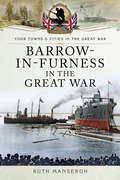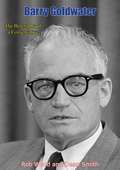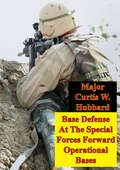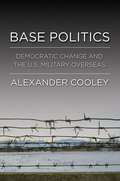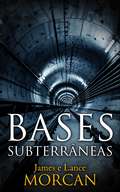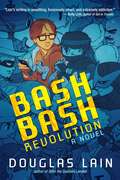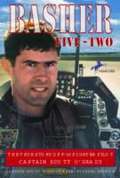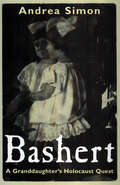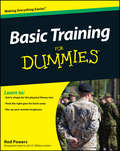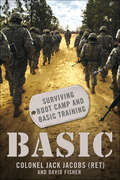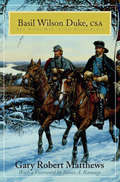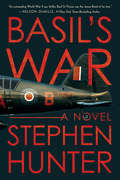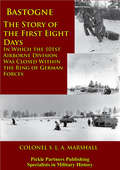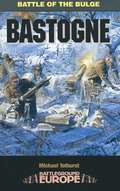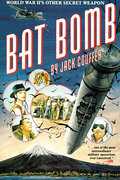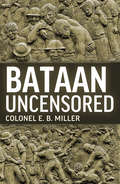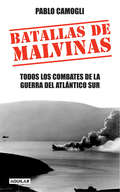- Table View
- List View
Barrow-in-Furness in the Great War (Your Towns & Cities in the Great War)
by Ruth ManserghThis book is about how Barrow's output of war materials was vital to the Great War effort, and it is about the Barrovians and men from the surrounding south Lakeland area - from all walks of life - who fought abroad, and the area's women war heroes. It includes background information on the history of the town, such as the Furness Railway, iron ore in the area and shipbuilding, and lists vessels built at Barrow pre- and during the war with information on what happened to them. These vessels include Mikasa and HMS Vanguard. At the outbreak of World War One, Vanguard fought in the battle of Jutland. The Mayfly (or the Won't Fly as Churchill called it), built by Vickers at Barrow along similar lines to the very early Zeppelins, was launched in 1911. She was the first British rigid airship to be built. Today, Astute submarines for the Royal Navy keep Barrow busy and local people turn up when new submarines are launched. This book also acts as a reference guide to local war dead and war heroes, lost heroes, the area's recipients of the Victoria Cross, memorials with details of those commemorated (including those whose names were unwelcome on memorials). Barrow's War Memorial in Barrow Park was unveiled in November, 1921 by Field Marshall Sir William "Wullie" Robertson and records close to 600 names of those who fought and died in the First World War.
Barry Goldwater: The Biography of a Conservative
by Rob Wood Dean SmithAN INTIMATE, HUMAN AND REVEALING PORTRAIT OF THE MAN WHO MADE SUCH A UNIQUE IMPACT UPON THE AMERICAN SCENE.BARRY GOLDWATER stands in the forefront of the new wave of American conservatism. His appeal is not only to those usually associated with vested interests but also to a large body of women, college students and Southerners.Allied against him are liberals, labor and Easterners. Almost without exception, Americans are lined up solidly for or against Barry Goldwater. There are few neutrals.Veteran reporters Wood and Smith have delved into the phenomenon of Barry Goldwater with piercing insight. Nothing is left out—from the rise of the family’s fortunes in Arizona to the growth of the Senator’s influence in Washington.This is a book that every responsible American—whatever his political beliefs—will want to read. It is the story of one of the most important and controversial figures in government and of his particular brand of conservatism.Illustrated and including excerpts, from his major speeches.
Base Defense At The Special Forces Forward Operational Bases
by Major Curtis W. HubbardSpecial Forces forward operational bases (FOB) are essential for mission and contingency planning as well as for the preparation, infiltration and exfiltration of Operational Detachment Alphas (ODA). Therefore, the defense of this command and control headquarters is critical for preserving combat power and synchronizing military actions in a theater of operations. Because the enemy has the capability of projecting forces with the objective of disrupting US military operations, FOBs have become likely targets.According to SF doctrine, FOBs should be located in secure areas with MP or host-nation personnel providing the bulk of the security force. Although this situation is preferable, it is by no means assured. FOBs should be able to provide their own security in the event other forces are not available or when rapid deployment restricts the flow of conventional forces into a theater of operations. After-action review results from the Joint Readiness Training Center demonstrate that many SF battalions are not prepared to execute base defense tasks without the assistance of other forces. Many SF commanders do not consider base defense a mission essential task and the result is a lack of training by many of their personnel.This study analyzes joint and SF doctrine, observations from the field, and the effects of the contemporary operating environment to identify weaknesses in the readiness of SF battalions.
Base Politics: Democratic Change and the U.S. Military Overseas
by Alexander CooleyAccording to the Department of Defense's 2004 Base Structure Report, the United States officially maintains 860 overseas military installations and another 115 on noncontinental U.S. territories. Over the last fifteen years the Department of Defense has been moving from a few large-footprint bases to smaller and much more numerous bases across the globe. This so-called lily-pad strategy, designed to allow high-speed reactions to military emergencies anywhere in the world, has provoked significant debate in military circles and sometimes-fierce contention within the polity of the host countries.In Base Politics, Alexander Cooley examines how domestic politics in different host countries, especially in periods of democratic transition, affect the status of U.S. bases and the degree to which the U.S. military has become a part of their local and national landscapes. Drawing on exhaustive field research in different host nations across East Asia and Southern Europe, as well as the new postcommunist base hosts in the Black Sea and Central Asia, Cooley offers an original and provocative account of how and why politicians in host countries contest or accept the presence of the U.S. military on their territory.Overseas bases, Cooley shows, are not merely installations that serve a military purpose. For host governments and citizens, U.S. bases are also concrete institutions and embodiments of U.S. power, identity, and diplomacy. Analyzing the degree to which overseas bases become enmeshed in local political agendas and interests, Base Politics will be required reading for anyone interested in understanding the extent-and limits-of America's overseas military influence.
Baseball Saved Us
by Ken MochizukiA Japanese American boy learns to play baseball when he and his family are forced to live in an internment camp during World War II, and his ability to play helps him after the war is over.
Bases Subterrâneas
by James Morcan Lance Morcan Anabela SousaBases Subterrâneas revela detalhes sobre instalações subterrâneas nos Estados Unidos e ao redor do mundo, confirmadas e rumorejadas. Contendo raras provas fotográficas, bem como citações pouco conhecidas de figuras chave do governo, lança argumentos convincentes para a existência de um enorme mundo oculto sob a superfície da terra.
Bash Bash Revolution
by Douglas LainSeventeen-year-old Matthew Munson is ranked thirteenth in the state in Bash Bash Revolution, an outdated Nintendo game from 2002 that, in 2016, is still getting tournament play. He’s a high school dropout who still lives at home with his mom, doing little but gaming and moping. That is, until Matthew’s dad turns up again. Jeffrey Munson is a computer geek who’d left home eight years earlier to work on a top secret military project. Jeff has been a sporadic presence in Matthew’s life, and much to his son’s displeasure insists on bonding over video games. The two start entering local tournaments together, where Jeff shows astonishing aptitude for Bash Bash Revolution in particular. Then, as abruptly as he appeared, Matthew’s father disappears again, just as he was beginning to let Jeff back into his life. The betrayal is life-shattering, and Matthew decides to give chase, in the process discovering the true nature of the government-sponsored artificial intelligence program his father has been involved in. Told as a series of conversations between Matthew and his father’s artificial intelligence program, Bash Bash Revolution is a wildly original novel of apocalypse and revolution, as well as a poignant story of broken family.
Basher Five-Two: The True Story of F-16 Fighter Pilot Captain Scott O'Grady
by Scott O'Grady Michael FrenchWhile flying his F-16 in Bosnia, O'Grady was shot down. His plane exploded and he parachuted down into enemy territory. This is how he evaded capture with little water and no food.
Bashert: A Granddaughter's Holocaust Quest (Willie Morris Books in Memoir and Biography)
by Andrea SimonHaunted by her grandmother's Old World stories and bigger-than-life persona, Andrea Simon undertook a spiritual search for her lost family. Her sojourn, a quest for truth, gave her tragic answers. On a group tour of ancestral Jewish homeland sites that had been crushed in the Holocaust, she makes a riveting detour to her grandmother's village of Volchin, in what is now Belarus, where the last known family members had lived. There, she followed the trail of the death march taken by the village Jews to the place of their slaughter by Nazis and Nazi collaborators in the fall of 1942. During the same period, in Brona Gora, a forest between Brest and Minsk, some 50,000 Jews were shot. Simon was in one of the first American groups to visit this little-publicized site. Bashert, the Yiddish word for fate, guided her through the arduous quest. With newly translated archival records, she peeled back layers of clues to confront the mystery. This story of her momentous odyssey reveals the terrible fate of her kin. Mass shootings of Jews, particularly in the Soviet Union, have not been addressed with the same focus given to concentration-camp atrocities. Yet Simon's research reveals that Nazis killed nearly fifty percent of their Jewish victims by means other than gassing. In the historiography of the era, comparatively scant reference is made to the executions at Brona Gora. Thus Simon fills a significant gap in Holocaust history by providing the most extensive report yet given on the executions at Brona Gora and Volchin. As she interweaves tragic narrative with evocative family anecdotes, Simon writes a story of life in czarist Russia and, within this frame, of her family's flight from pogroms and persecution. From a unique vantage Simon's memoir discloses her dogged genealogical search, the newly perceived Jewish history she uncovered, and the ramifications of the Holocaust in the postwar generation.
Basic Training For Dummies
by Rod PowersThe easy way to prepare for basic trainingEach year, thousands of young Americans attempt to enlist in the U.S. Armed Services. A number of factors during a soldier's training could inhibit successful enlistment, including mental toughness and physical fitness levels. Basic Training For Dummies covers the ins and outs of this initial process, preparing you for the challenges you?ll face before you head off for basic training..You'll get detailed, week-by-week information on what to expect in basic training for each branch of service, such as physical training, discipline, classroom instruction, drill and ceremony, obstacle courses, simulated war games, self-defense, marksmanship, and other milestones.Tips and information on getting in shape to pass the Physical Fitness Test (PFT)All-important advice on what to pack for boot camp Other title by Powers: ASVAB For Dummies Premier, 3rd Edition, Veterans Benefits For DummiesWhether you join the Army, Air Force, Navy, Marine Corps, or the Coast Guard, Basic Training For Dummies prepares you for the challenge and will help you survive and thrive in boot camp!
Basic: Surviving Boot Camp and Basic Training
by David Fisher Jack JacobsEvery American fighting man and woman share one thing in common: they have all survived basic military training. Basic tells the story of that training.Medal of Honor recipient Col. Jack Jacobs and David Fisher recount the funny, sad, dramatic, poignant, and sometimes crazy history of how America has trained its military, told through the personal accounts of those who remember the experiences as if they happened yesterday.If you've been through basic or boot camp, these memories of drill instructors, marching chants, combat training (and the "gas chamber"), hospital corners, and the shared feeling of triumph are guaranteed to make you smile. And those who haven't done it will understand and appreciate this life-changing experience that turns a civilian into a soldier—and in just eight weeks.
Basil Wilson Duke, CSA: The Right Man in the Right Place
by Gary Robert MatthewsThe first biography of &“one of Kentucky&’s best Confederates . . . [who] became a good citizen working for reconciliation between North and South.&”—The Post and Courier After practicing law for several years in St. Louis, Basil Wilson Duke (1838-1916) enlisted in the Confederate army in 1861 and was elected first lieutenant of John Hunt Morgan&’s legendary cavalry unit. As second in command, he was, Morgan recorded, &“wise in counsel, gallant in the field,&” and always &“the right man in the right place.&” Duke was twice wounded in battle and was captured during Morgan&’s Great Raid and held prisoner for over a year. When Morgan, who was also Duke&’s brother-in-law, was killed in 1864, Duke was promoted to brigadier general and appointed commander of Morgan&’s men. Moving to join forces with those of Gen. Joseph E. Johnston&’s army in North Carolina, he was assigned to the force escorting Jefferson Davis in his retreat from Richmond at the close of the war. Basil Wilson Duke, CSA, the definitive biography of this important but often overlooked figure in Civil War history, establishes that Duke was in fact the brilliant tactician behind much of the success of Morgan&’s cavalry. Author Gary Robert Matthews not only offers an in-depth study of Duke&’s celebrated Civil War exploits but also traces his varied postwar literary, legal, and political careers. &“Fascinating . . . a vividly written story about a modest Southern gentleman in which the reader may come to his own conclusion that Basil W. Duke was the power behind Morgan&’s so-called military genius.&”—Edison H. Thomas, author of John Hunt Morgan and His Raiders
Basil's War
by Stephen HunterA swashbuckling British agent goes behind enemy lines to search for a religious text that might hold the key to ending the second World War Basil St. Florian is an accomplished agent in the British Army, tasked with dozens of dangerous missions for crown and country across the globe. But his current mission, going undercover in Nazi-occupied France during World War II, might be his toughest assignment yet. He will be searching for an ecclesiastic manuscript that doesn’t officially exist, one that genius professor Alan Turing believes may hold the key to a code that could prevent the death of millions and possibly even end the war. St. Florian isn’t the classic British special agent with a stiff upper lip—he is a swashbuckling, whisky-drinking cynic and thrill-seeker who resents having to leave Vivien Leigh’s bed to set out on his crucial mission. Despite these proclivities, though, Basil’s Army superiors know he’s the best man for the job, carrying out his espionage with enough charm and quick wit to make any of his subjects lower their guards. Action-packed and bursting with WWII-era intrigue (much of which has basis in fact), Basil’s War is a classic espionage thriller from Pulitzer Prize-winning critic, essayist, and bestselling novelist Stephen Hunter.
Bastogne - The Story Of The First Eight Days: In Which The 101st Airborne Division Was Closed Within The Ring Of German Forces [Illustrated Edition]
by S. L. A. Marshall[This edition benefits from numerous maps of the battlefields that the actions were fought over]"NUTS!" - Among the many military legends that abound from the fighting of the Second World War, the one word reply to a German summons to surrender must rank highly in terms of its resonance, importance and sheer grit. General Mcaulliffe decided that despite the odds and the lack of supplies and ammunition his troops would continue to hold the important communication hub of Bastogne during the Battle of the Bulge. This dramatic, yet authoritative account brings all of the action to the fore as the Battered Bastards of Bastogne wrote their names into legend."THIS STORY OF BASTOGNE was written from interviews with nearly all the commanders and staff officers and many of the men who participated in the defense of Bastogne during the first phase of that now celebrated operation--the days during which the American forces were surrounded by forces of the enemy...Thus it is essentially the account of how a single strong defensive force was built from separate commands of armor, airborne infantry and tank destroyers--a force convinced that it could not be beaten."-Introduction.
Bastogne: Battle of the Bulge (Battleground Europe)
by Michael TolhurstBy Christmas 1944, the Allies were on the threshold of victory, having remorselessly rolled the Germans back to the very borders of "The Fatherland". The, the shock of a massive Nazi counter-attack through the Ardennes in the depth of winter threw the Allies into confusion. Bastogne was at the very centre of this dramatic and most dangerous setback.
Bat Bomb: World War II's Other Secret Weapon
by Jack CoufferIt was a crazy way to win World War II in the Pacific— All the United States had to do was to attach small incendiary bombs to millions of bats and release them over Japan's major cities. As the bats went to roost, a million fires would flare up in remote crannies of the wood and paper buildings common throughout Japan. When their cities were reduced to ashes, the Japanese would surely capitulate... The plan made sense to a handful of eccentric promoters and researchers, who convinced top military brass and even President Roosevelt to back the scheme. It might have worked, except that another secret weapon—something to do with atoms—was chosen to end the war. Told here by the youngest member of the team, this is the story of the bat bomb project, or Project X-Ray, as it was officially known. In scenes worthy of a Capra or Hawks comedy, Jack Couffer recounts the unorthodox experiments carried out in the secrecy of Bandera, Texas, Carlsbad, New Mexico, and El Centro, California, in 1942-1943 by "Doc" Adams' private army. This oddball cast of characters included an eccentric inventor, a distinguished Harvard scientist, a biologist with a chip on his shoulder, a movie star, a Texas guano collector, a crusty Marine Corps colonel, a Maine lobster fisherman, an ex-mobster, and a tiger. Not to be defeated by minor logistical hurdles, the bat bomb researchers risked life and limb to explore uncharted bat caves and "recruit" thousands of bats to serve their country. Through months of personality conflicts, military snafus, and technical failures the team pressed on, certain that bats could end the war with Japan. And they might have—in their first airborne test, the bat bombers burned an entire brand-new military airfield to the ground. For everyone who relishes true tales of action and adventure, Bat Bomb is a must-read. Bat enthusiasts will also discover the beginnings of the scientific study of bats.
Bat Bomb: World War II's Other Secret Weapon
by Jack Couffer&“Inside information on a wondrously droll, highly classified yarn from WWII . . . A well-told, stranger-than-fiction tale that could make a terrific movie.&” —Kirkus Reviews The plan: attach small incendiary bombs to millions of bats and release them over Japan&’s major cities. As the bats went to roost, a million fires would flare up in remote crannies of the wood and paper buildings common throughout Japan. When their cities were reduced to ashes, the Japanese would surely capitulate . . . Told here by the youngest member of the team, this is the story of the bat bomb project, or Project X-Ray, as it was officially known. In scenes worthy of a Capra or Hawks comedy, Jack Couffer recounts the unorthodox experiments carried out in the secrecy of Bandera, Texas, Carlsbad, New Mexico, and El Centro, California, in 1942-1943 by &“Doc&” Adams&’ private army. This oddball cast of characters included an eccentric inventor, a distinguished Harvard scientist, a biologist with a chip on his shoulder, a movie star, a Texas guano collector, a crusty Marine Corps colonel, a Maine lobster fisherman, an ex-mobster, and a tiger. The bat bomb researchers risked life and limb to explore uncharted bat caves and &“recruit&” thousands of bats to serve their country, certain that they could end the war with Japan. And they might have—in their first airborne test, the bat bombers burned an entire brand-new military airfield to the ground. For everyone who relishes true tales of action and adventure, Bat Bomb is a must-read. Bat enthusiasts will also discover the beginnings of the scientific study of bats.
Bataan Uncensored
by Col. Ernest MillerBataan Uncensored, published in 1949, is the first-hand account by U.S. Army Colonel Ernest Miller of his experiences in the battle for Bataan, his subsequent surrender and participation in the infamous "Death March," followed by imprisonment at Camps O'Donnell and Cabanatuan, and finally transfer to a labor camp in Japan on a cramped, fetid "Hell Ship." Upon their arrival in the Philippines, Miller, commander of an armored National Guard unit from Minnesota—the 194th Tank Battalion—and his troops are soon thrown into the thick of the fighting in a desperate attempt to slow the Japanese take-over. The U.S. And Philippine armies, grossly unprepared for the massive Japanese invasions, do not have a chance of victory, compounded by their obsolete equipment, lack of fuel and food, and a chaotic command structure. Once in captivity, the struggle to survive begins, hindered by always inadequate food, no medicines to treat raging diseases such as malaria and dysentery, and beatings at the hands of sadistic guards. As the author states, by war's end, 75% of his battalion did not return to the United States. Unlike other works dealing with the U.S. military in the Philippines in the Second World War, Bataan Uncensored realistically portrays the experiences of the soldiers but also identifies critical weaknesses in American policy and tactics that greatly affected the outcome of the battle. Included are 11 pages of maps.
Bataan: The Judgment Seat
by Allison IndBataan: the Judgment Seat, first published in 1944 is the account of Lieutenant Colonel Allison Ind about U.S. preparations and defenses prior to and during the Japanese invasion of the Philippines. Ind, an Air Intelligence Officer, provides a blow-by-blow account of his activities within the broader picture of the war, from the tense days before the attack on Pearl Harbor, to the frantic scrambling of unprepared and under-equipped American and Filipino fighting forces, to the defense and fall of Bataan and Corregidor. The book ends with Ind leaving the Philippines via Mindanao for Australia with his commanding officer. Bataan: the Judgment Seat remains a sobering look at America's military in the Pacific during the early days of the Second World War.
Batallas de Malvinas: Todos los combates de la Guerra del Atlántico Sur
by Pablo CamogliUna obra imprescindible para que la guerra de Malvinas deje de ser una parte silenciada de nuestra historia cercana. ¿Cuál fue el significado de la guerra de Malvinas? ¿Se trató de una lucha justa contra un dominio colonial anacrónico o no fue más que la estrategia de escape de un régimen dictatorial que ya no podía ocultar su crisis? Encontrar las respuestas a estas preguntas no es tarea fácil. La necesidad de pasar de las emociones al juicio objetivo es todavía un desafío pendiente para la sociedad, que, embanderada en la causa desde una u otra posición, llena con ideología los análisis y favorece de ese modo la existencia de ese #manto de neblina# que cubre todavía los sucesos de una guerra cruda, disputada en tierras inhóspitas. Pablo Camogli se propone ayudar a descorrer ese velo mediante la exposición detallada de los hechos bélicos, porque #sin las bombas, sin la muerte, sin el hambre y el frío, ningún análisis estaría completo, ninguna conclusión sería acertada#. Tras una minuciosa investigación, enriquecida con testimonios de los protagonistas, Batallas de Malvinas cuestiona medias verdades y mitos difundidos tras la guerra para favorecer intereses políticos parciales. Revela qué pasó durante esos setenta y cuatro días, con qué capacidad militar se contó y cómo fue utilizada, cuál fue el espíritu de los soldados frente al enemigo, cómo actuaron las Fuerzas Armadas como institución y también de manera individual, sobre todo a la hora del combate, cuál fue el planteo estratégico y con qué tácticas se lo llevó a cabo.
Batallas decisivas de la historia de España
by Juan Carlos LosadaLas grandes batallas que conformaron el futuro de España. Este libro presenta una amena aproximación a los hechos bélicos que marcaron decisivamente el devenir de los acontecimientos en nuestro país. Analizar las batallas, las causas de las mismas, así como las trascendentales consecuencias de sus resultados es el objetivo de esta obra. En ella se analizan pormenorizadamente algunos episodios bélicos fundamentales, desde la Alta Edad Media hasta comienzos del siglo XIX. Juan Carlos Losada trata, por otra parte, de hacer reflexionar al lector sobre lo diferente que podría haber sido la historia de España de no haberse producido estos terribles enfrentamientos, y sobre el papel de la violencia en la construcción de los Estados.
Batallas entre hermanos: Todos los combates de las guerras civiles argentinas
by Pablo CamogliUn recorrido por más de cien años de luchas civiles en el proceso de surgimiento de la nación y la construcción del Estado argentino. «En 1813, una lucha entre dos grupos de guaraníes acabó en un enfrentamiento armado. Los protagonistas nunca lo sabrían, pero este conflicto marcó el inicio de la guerra civil en la Argentina. Sólo 101 años después, esa guerra tendría su conclusión formal.» Este libro recorre esos más de cien años de luchas fratricidas, para develar el papel central que los enfrentamientos armados tuvieron en el surgimiento de la nación y la construcción del Estado argentino. Tanto en la definición del modelo de país como en la delimitación de su territorio, esas guerras civiles no sólo acompañaron la evolución política, sino que en muchos casos la decidieron y determinaron. Con una novedosa y fundamentada interpretación, se incluye la llamada "guerra contra el indio" en el contexto de esas luchas entre hermanos. A partir de una documentada investigación, Pablo Camogli relata las batallas que jalonan esos procesos históricos. Detalla las fuerzas enfrentadas, los recursos de que disponían, los jefes que las comandaban, las tácticas aplicadas, los escenarios donde se produjeron y los resultados de más de cuatrocientos combates, en su correspondiente contexto político, social y económico. Brinda así una visión a la vez integral y pormenorizada de un aspecto central para comprender el surgimiento y la consolidación de la Argentina.
Bath at War, 1939–45 (Your Towns And Cities In World War Two Ser.)
by David Lassman Nigel LassmanBath at War 1939-45 is a comprehensive account of the citys experience of the conflict, covering in detail life on the Home Front set against the background of the wider theatres of war.The narrative of that global struggle is given with a focus on the ordeals endured by the people of Bath, as they cheered their men and women fighters off to war, welcomed thousands of evacuated men, women and children to the city, and faced the full might of Hitlers Luftwaffe.Rare insights into the life of the war-torn city are included, along with untold stories from the footnotes of history, from the Bath blitz to the influx of American GIs. The book incorporates memoirs and memories, along with in depth research from official records and newspaper accounts, so the reader sees the war from the perspective of ordinary people, although the military experiences of Baths citizens - and in many cases their tragic sacrifices - are also included.More controversial topics are also touched upon, such as civil defense, military injustice, racism and local politics, to give a full and fascinating picture of a great city facing profound trials of endurance and courage, thus revealing the many characteristics which has sustained Bath throughout its illustrious history.
Bath in the Great War (Your Towns & Cities in the Great War)
by Derek TaitWhen news of the war broke out in 1914, nothing could prepare the citizens of Bath for the changes that would envelop their city over the next four years. The story of Bath in the Great War is both an interesting and intriguing one. This book covers this historic city's involvement from the commencement of the Great War in July 1914, to the Armistice in November 1918, describing in great detail what happened to the city and its people, including their everyday lives, entertainment, spies and the internment of aliens living within the city. Bath played a key role in the deployment of troops to Northern Europe as well as supplying vital munitions. Local men responded keenly to recruitment drives and thousands of soldiers were billeted in the city before being sent off to fight the enemy overseas. The city also played a vital role caring for the many wounded soldiers who returned home from the front. As the end of the war was announced there were tremendous celebrations in the streets, but the effects of war lasted for years to come. By the end of the conflict, there wasn't a family in Bath who hadn't lost a son, father, nephew, uncle or brother. Bath features many forgotten news stories of the day and includes a considerable collection of rare photographs last seen in newspapers nearly 70 years ago.
Battersea Girl: Tracing a London Life
by Martin KnightA couple of years ago, Martin Knight began a quest to delve into his family history. He had a head start on many amateur genealogists, as 30 years earlier he had produced a school project on the very subject. The project was based on the papers and oral history of his then elderly grandmother, Ellen Tregent. Martin dusted this off and began to assemble the chain of events that shaped his grandmother's life. He even made contact with several living relatives who had known Ellen or some of the people and events she described.Ellen Tregent was born in 1888 and died in 1988 - her lifetime encompassing an unprecedented century of social change and world upheaval. She was born into a poor working-class family in Battersea, London. Her grandfather had arrived from Ireland 40 years earlier to escape almost certain death as potato famine ravaged his country. In Battersea Girl, Martin Knight charts Ellen's long and eventful life and the lives of her siblings. They encounter abject poverty, disease, suicide, murder, war and inevitably death, but, equally, the spirit of stoical people who were determined to make the most of their lives shines through in this enchanting book.
